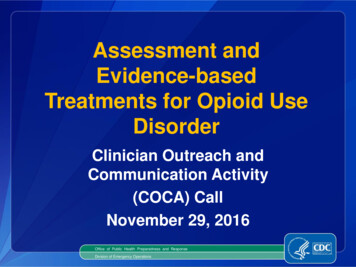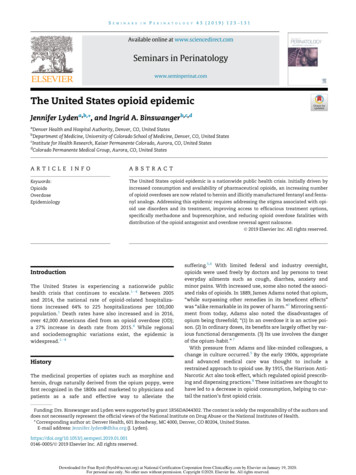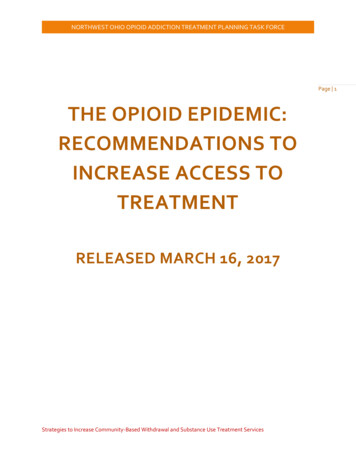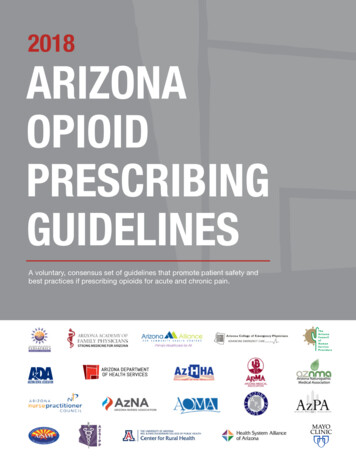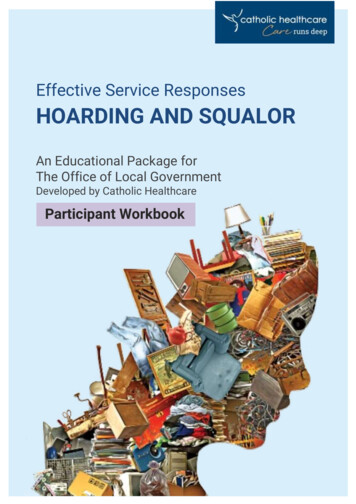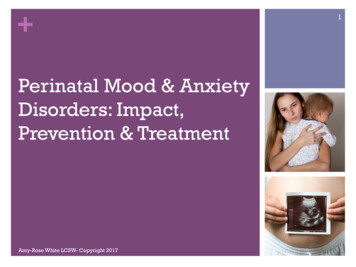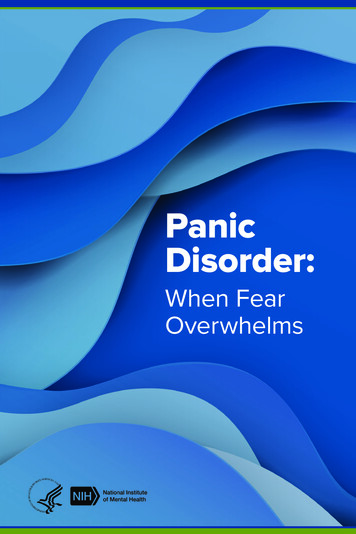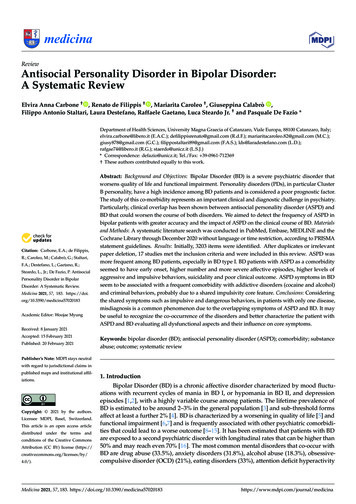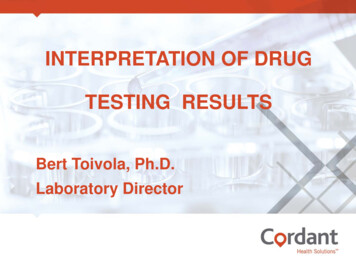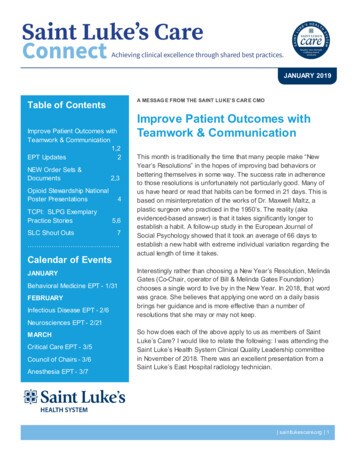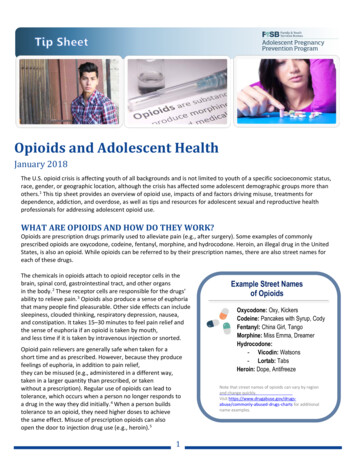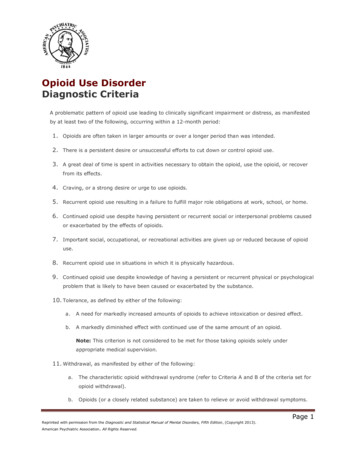
Transcription
Opioid Use DisorderDiagnostic CriteriaA problematic pattern of opioid use leading to clinically significant impairment or distress, as manifestedby at least two of the following, occurring within a 12-month period:1. Opioids are often taken in larger amounts or over a longer period than was intended.2. There is a persistent desire or unsuccessful efforts to cut down or control opioid use.3. A great deal of time is spent in activities necessary to obtain the opioid, use the opioid, or recoverfrom its effects.4. Craving, or a strong desire or urge to use opioids.5. Recurrent opioid use resulting in a failure to fulfill major role obligations at work, school, or home.6. Continued opioid use despite having persistent or recurrent social or interpersonal problems causedor exacerbated by the effects of opioids.7. Important social, occupational, or recreational activities are given up or reduced because of opioiduse.8. Recurrent opioid use in situations in which it is physically hazardous.9. Continued opioid use despite knowledge of having a persistent or recurrent physical or psychologicalproblem that is likely to have been caused or exacerbated by the substance.10. Tolerance, as defined by either of the following:a.A need for markedly increased amounts of opioids to achieve intoxication or desired effect.b.A markedly diminished effect with continued use of the same amount of an opioid.Note: This criterion is not considered to be met for those taking opioids solely underappropriate medical supervision.11. Withdrawal, as manifested by either of the following:a.The characteristic opioid withdrawal syndrome (refer to Criteria A and B of the criteria set foropioid withdrawal).b.Opioids (or a closely related substance) are taken to relieve or avoid withdrawal symptoms.Page 1Reprinted with permission from the Diagnostic and Statistical Manual of Mental Disorders, Fifth Edition, (Copyright 2013).American Psychiatric Association All Rights Reserved.
Note: This criterion is not considered to be met for those individuals taking opioids solelyunder appropriate medical supervision.Specify if: In early remission: After full criteria for opioid use disorder were previously met, none ofthe criteria for opioid use disorder have been met for at least 3 months but for less than 12months (with the exception that Criterion A4, “Craving, or a strong desire or urge to useopioids,” may be met). In sustained remission: After full criteria for opioid use disorder were previously met, noneof the criteria for opioid use disorder have been met at any time during a period of 12months or longer (with the exception that Criterion A4, “Craving, or a strong desire or urgeto use opioids,” may be met).Specify if: On maintenance therapy: This additional specifier is used if the individual is taking aprescribed agonist medication such as methadone or buprenorphine and none of the criteriafor opioid use disorder have been met for that class of medication (except tolerance to, orwithdrawal from, the agonist). This category also applies to those individuals beingmaintained on a partial agonist, an agonist/antagonist, or a full antagonist such as oralnaltrexone or depot naltrexone. In a controlled environment: This additional specifier is used if the individual is in anenvironment where access to opioids is restricted.Coding based on current severity: Note for ICD-10-CM codes: If an opioid intoxication, opioidwithdrawal, or another opioid-induced mental disorder is also present, do not use the codes below for opioiduse disorder. Instead, the comorbid opioid use disorder is indicated in the 4th character of the opioidinduced disorder code (see the coding note for opioid intoxication, opioid withdrawal, or a specific opioidinduced mental disorder). For example, if there is comorbid opioid-induced depressive disorder and opioiduse disorder, only the opioid-induced depressive disorder code is given, with the 4th character indicatingwhether the comorbid opioid use disorder is mild, moderate, or severe: F11.14 for mild opioid use disorderwith opioid-induced depressive disorder or F11.24 for a moderate or severe opioid use disorder with opioidinduced depressive disorder.Specify current severity: 305.50 (F11.10) Mild: Presence of 2–3 symptoms. 304.00 (F11.20) Moderate: Presence of 4–5 symptoms.Page 2Reprinted with permission from the Diagnostic and Statistical Manual of Mental Disorders, Fifth Edition, (Copyright 2013).American Psychiatric Association All Rights Reserved.
304.00 (F11.20) Severe: Presence of 6 or more symptoms.SpecifiersThe “on maintenance therapy” specifier applies as a further specifier of remission if the individual is both inremission and receiving maintenance therapy. “In a controlled environment” applies as a further specifier ofremission if the individual is both in remission and in a controlled environment (i.e., in early remission in acontrolled environment or in sustained remission in a controlled environment). Examples of theseenvironments are closely supervised and substance-free jails, therapeutic communities, and locked hospitalunits.Changing severity across time in an individual is also reflected by reductions in the frequency (e.g., days ofuse per month) and/or dose (e.g., injections or number of pills) of an opioid, as assessed by the individual’sself-report, report of knowledgeable others, clinician’s observations, and biological testing.Diagnostic FeaturesOpioid use disorder includes signs and symptoms that reflect compulsive, prolonged self-administration ofopioid substances that are used for no legitimate medical purpose or, if another medical condition is presentthat requires opioid treatment, that are used in doses greatly in excess of the amount needed for thatmedical condition. (For example, an individual prescribed analgesic opioids for pain relief at adequate dosingwill use significantly more than prescribed and not only because of persistent pain.) Individuals with opioiduse disorder tend to develop such regular patterns of compulsive drug use that daily activities are plannedaround obtaining and administering opioids. Opioids are usually purchased on the illegal market but mayalso be obtained from physicians by falsifying or exaggerating general medical problems or by receivingsimultaneous prescriptions from several physicians. Health care professionals with opioid use disorder willoften obtain opioids by writing prescriptions for themselves or by diverting opioids that have been prescribedfor patients or from pharmacy supplies. Most individuals with opioid use disorder have significant levels oftolerance and will experience withdrawal on abrupt discontinuation of opioid substances. Individuals withopioid use disorder often develop conditioned responses to drug-related stimuli (e.g., craving on seeing anyheroin powder–like substance)—a phenomenon that occurs with most drugs that cause intense psychologicalchanges. These responses probably contribute to relapse, are difficult to extinguish, and typically persistlong after detoxification is completed (Fatseas et al. 2011b).Associated Features Supporting DiagnosisOpioid use disorder can be associated with a history of drug-related crimes (e.g., possession or distributionof drugs, forgery, burglary, robbery, larceny, receiving stolen goods). Among health care professionals andindividuals who have ready access to controlled substances, there is often a different pattern of illegalactivities involving problems with state licensing boards, professional staffs of hospitals, or otherPage 3Reprinted with permission from the Diagnostic and Statistical Manual of Mental Disorders, Fifth Edition, (Copyright 2013).American Psychiatric Association All Rights Reserved.
administrative agencies. Marital difficulties (including divorce), unemployment, and irregular employmentare often associated with opioid use disorder at all socioeconomic levels.PrevalenceThe 12-month prevalence of opioid use disorder is approximately 0.37% among adults age 18 years andolder in the community population (Compton et al. 2007). This may be an underestimate because of thelarge number of incarcerated individuals with opioid use disorders (Compton et al. 2010). Rates are higherin males than in females (0.49% vs. 0.26%), with the male-to-female ratio typically being 1.5:1 for opioidsother than heroin (i.e., available by prescription) and 3:1 for heroin. Female adolescents may have a higherlikelihood of developing opioid use disorders (Wu et al. 2009). The prevalence decreases with age, with theprevalence highest (0.82%) among adults age 29 years or younger, and decreasing to 0.09% among adultsage 65 years and older. Among adults, the prevalence of opioid use disorder is lower among AfricanAmericans at 0.18% and overrepresented among Native Americans at 1.25%. It is close to average amongwhites (0.38%), Asian or Pacific Islanders (0.35%), and Hispanics (0.39%) (Wu et al. 2009).Among individuals in the United States ages 12–17 years, the overall 12-month prevalence of opioid usedisorder in the community population is approximately 1.0%, but the prevalence of heroin use disorder isless than 0.1%. By contrast, analgesic use disorder is prevalent in about 1.0% of those ages 12–17 years,speaking to the importance of opioid analgesics as a group of substances with significant healthconsequences (Substance Abuse and Mental Health Services Administration 2011).The 12-month prevalence of problem opioid use in European countries in the community population ages15–64 years is between 0.1% and 0.8%. The average prevalence of problem opioid use in the EuropeanUnion and Norway is between 0.36% and 0.44% (European Monitoring Centre for Drugs and Drug Addiction2010).Development and CourseOpioid use disorder can begin at any age, but problems associated with opioid use are most commonly firstobserved in the late teens or early 20s. Once opioid use disorder develops, it usually continues over a periodof many years, even though brief periods of abstinence are frequent. In treated populations, relapsefollowing abstinence is common. Even though relapses do occur, and while some long-term mortality ratesmay be as high as 2% per year, about 20%–30% of individuals with opioid use disorder achieve long-termabstinence. An exception concerns that of military service personnel who became dependent on opioids inVietnam; over 90% of this population who had been dependent on opioids during deployment in Vietnamachieved abstinence after they returned, but they experienced increased rates of alcohol or amphetamineuse disorder as well as increased suicidality (Price et al. 2001).Page 4Reprinted with permission from the Diagnostic and Statistical Manual of Mental Disorders, Fifth Edition, (Copyright 2013).American Psychiatric Association All Rights Reserved.
Increasing age is associated with a decrease in prevalence as a result of early mortality and the remission ofsymptoms after age 40 years (i.e., “maturing out”). However, many individuals continue have presentationsthat meet opioid use disorder criteria for decades (Hser et al. 2007).Risk and Prognostic FactorsGenetic and physiologicalThe risk for opiate use disorder can be related to individual, family, peer, and social environmental factors(Kendler et al. 2003; Tsuang et al. 1998), but within these domains, genetic factors play a particularlyimportant role both directly and indirectly. For instance, impulsivity and novelty seeking are individualtemperaments that relate to the propensity to develop a substance use disorder but may themselves begenetically determined. Peer factors may relate to genetic predisposition in terms of how an individualselects his or her environment.Culture-Related Diagnostic IssuesDespite small variations regarding individual criterion items, opioid use disorder diagnostic criteria performequally well across most race/ethnicity groups. Individuals from ethnic minority populations living ineconomically deprived areas have been overrepresented among individuals with opioid use disorder.However, over time, opioid use disorder is seen more often among white middle-class individuals, especiallyfemales, suggesting that differences in use reflect the availability of opioid drugs and that other socialfactors may impact prevalence. Medical personnel who have ready access to opioids may be at increasedrisk for opioid use disorder.Diagnostic MarkersRoutine urine toxicology test results are often positive for opioid drugs in individuals with opioid usedisorder. Urine test results remain positive for most opioids (e.g., heroin, morphine, codeine, oxycodone,propoxyphene) for 12–36 hours after administration. Fentanyl is not detected by standard urine tests butcan be identified by more specialized procedures for several days. Methadone, buprenorphine (orbuprenorphine/naloxone combination), and LAAM (L-alpha-acetylmethadol) have to be specifically tested forand will not cause a positive result on routine tests for opiates. They can be detected for several days up tomore than 1 week. Laboratory evidence of the presence of other substances (e.g., cocaine, marijuana,alcohol, amphetamines, benzodiazepines) is common. Screening test results for hepatitis A, B, and C virusare positive in as many as 80%–90% of injection opioid users, either for hepatitis antigen (signifying activeinfection) or for hepatitis antibody (signifying past infection). HIV is prevalent in injection opioid users aswell. Mildly elevated liver function test results are common, either as a result of resolving hepatitis or fromtoxic injury to the liver due to contaminants that have been mixed with the injected opioid. Subtle changesPage 5Reprinted with permission from the Diagnostic and Statistical Manual of Mental Disorders, Fifth Edition, (Copyright 2013).American Psychiatric Association All Rights Reserved.
in cortisol secretion patterns and body temperature regulation have been observed for up to 6 monthsfollowing opioid detoxification.Suicide RiskSimilar to the risk generally observed for all substance use disorders, opioid use disorder is associated with aheightened risk for suicide attempts and completed suicides. Particularly notable are both accidental anddeliberate opioid overdoses. Some suicide risk factors overlap with risk factors for an opioid use disorder. Inaddition, repeated opioid intoxication or withdrawal may be associated with severe depressions that,although temporary, can be intense enough to lead to suicide attempts and completed suicides. Availabledata suggest that nonfatal accidental opioid overdose (which is common) and attempted suicide are distinctclinically significant problems that should not be mistaken for each other.Functional Consequences of Opioid Use DisorderOpioid use is associated with a lack of mucous membrane secretions, causing dry mouth and nose. Slowingof gastrointestinal activity and a decrease in gut motility can produce severe constipation. Visual acuity maybe impaired as a result of pupillary constriction with acute administration. In individuals who inject opioids,sclerosed veins (“tracks”) and puncture marks on the lower portions of the upper extremities are common.Veins sometimes become so severely sclerosed that peripheral edema develops, and individuals switch toinjecting in veins in the legs, neck, or groin. When these veins become unusable, individuals often injectdirectly into their subcutaneous tissue (“skin-popping”), resulting in cellulitis, abscesses, and circularappearing scars from healed skin lesions. Tetanus and Clostridium botulinum infections are relatively rarebut extremely serious consequences of injecting opioids, especially with contaminated needles. Infectionsmay also occur in other organs and include bacterial endocarditis, hepatitis, and HIV infection. Hepatitis Cinfections, for example, may occur in up to 90% of persons who inject opioids. In addition, the prevalence ofHIV infection can be high among individuals who inject drugs, a large proportion of whom are individualswith opioid use disorder. HIV infection rates have been reported to be as high as 60% among heroin userswith opioid use disorder in some areas of the United States or the Russian Federation. However, theincidence may also be 10% or less in other areas, especially those where access to clean injection materialand paraphernalia is facilitated (Fatseas et al. 2011a).Tuberculosis is a particularly serious problem among individuals who use drugs intravenously, especiallythose who are dependent on heroin; infection is usually asymptomatic and evident only by the presence of apositive tuberculin skin test. However, many cases of active tuberculosis have been found, especially amongthose who are infected with HIV. These individuals often have a newly acquired infection but also are likelyto experience reactivation of a prior infection because of impaired immune function.Individuals who sniff heroin or other opioids into the nose (“snorting”) often develop irritation of the nasalmucosa, sometimes accompanied by perforation of the nasal septum. Difficulties in sexual functioning arePage 6Reprinted with permission from the Diagnostic and Statistical Manual of Mental Disorders, Fifth Edition, (Copyright 2013).American Psychiatric Association All Rights Reserved.
common. Males often experience erectile dysfunction during intoxication or chronic use. Females commonlyhave disturbances of reproductive function and irregular menses.In relation to infections such as cellulitis, hepatitis, HIV infection, tuberculosis, and endocarditis, opioid usedisorder is associated with a mortality rate as high as 1.5%–2% per year. Death most often results fromoverdose, accidents, injuries, AIDS, or other general medical complications. Accidents and injuries due toviolence that is associated with buying or selling drugs are common. In some areas, violence accounts formore opioid-related deaths than overdose or HIV infection. Physiological dependence on opioids may occurin about half of the infants born to females with opioid use disorder; this can produce a severe withdrawalsyndrome requiring medical treatment. Although low birth weight is also seen in children of mothers withopioid use disorder, it is usually not marked and is generally not associated with serious adverseconsequences.Differential DiagnosisOpioid-induced mental disordersOpioid-induced disorders occur frequently in individuals with opioid use disorder. Opioid-induced disordersmay be characterized by symptoms (e.g., depressed mood) that resemble primary mental disorders (e.g.,persistent depressive disorder [dysthymia] vs. opioid-induced depressive disorder, with depressive features,with onset during intoxication). Opioids are less likely to produce symptoms of mental disturbance than aremost other drugs of abuse. Opioid intoxication and opioid withdrawal are distinguished from the otheropioid-induced disorders (e.g., opioid-induced depressive disorder, with onset during intoxication) becausethe symptoms in these latter disorders predominate the clinical presentation and are severe enough towarrant independent clinical attention.Other substance intoxicationAlcohol intoxication and sedative, hypnotic, or anxiolytic intoxication can cause a clinical picture thatresembles that for opioid intoxication. A diagnosis of alcohol or sedative, hypnotic, or anxiolytic intoxicationcan usually be made based on the absence of pupillary constriction or the lack of a response to naloxonechallenge. In some cases, intoxication may be due both to opioids and to alcohol or other sedatives. Inthese cases, the naloxone challenge will not reverse all of the sedative effects.Other withdrawal disordersThe anxiety and restlessness associated with opioid withdrawal resemble symptoms seen in sedativehypnotic withdrawal. However, opioid withdrawal is also accompanied by rhinorrhea, lacrimation, andpupillary dilation, which are not seen in sedative-type withdrawal. Dilated pupils are also seen inhallucinogen intoxication and stimulant intoxication. However, other signs or symptoms of opioid withdrawal,such as nausea, vomiting, diarrhea, abdominal cramps, rhinorrhea, or lacrimation, are not present.Page 7Reprinted with permission from the Diagnostic and Statistical Manual of Mental Disorders, Fifth Edition, (Copyright 2013).American Psychiatric Association All Rights Reserved.
ComorbidityThe most common medical conditions associated with opioid use disorder are viral (e.g., HIV, hepatitis Cvirus) and bacterial infections, particularly among users of opioids by injection. These infections are lesscommon in opioid use disorder with prescription opioids. Opioid use disorder is often associated with othersubstance use disorders, especially those involving tobacco, alcohol, cannabis, stimulants, andbenzodiazepines, which are often taken to reduce symptoms of opioid withdrawal or craving for opioids, orto enhance the effects of administered opioids. Individuals with opioid use disorder are at risk for thedevelopment of mild to moderate depression that meets symptomatic and duration criteria for persistentdepressive disorder (dysthymia) or, in some cases, for major depressive disorder (Compton et al. 2005).These symptoms may represent an opioid-induced depressive disorder or an exacerbation of a preexistingprimary depressive disorder. Periods of depression are especially common during chronic intoxication or inassociation with physical or psychosocial stressors that are related to the opioid use disorder. Insomnia iscommon, especially during withdrawal. Antisocial personality disorder is much more common in individualswith opioid use disorder than in the general population (Compton et al. 2005). Posttraumatic stress disorderis also seen with increased frequency (Price et al. 2004). A history of conduct disorder in childhood oradolescence has been identified as a significant risk factor for substance-related disorders, especially opioiduse disorder.References: Opioid Use DisorderCompton WM, Conway KP, Stinson FS, et al: Prevalence, correlates, and comorbidity of DSM-IV antisocialpersonality syndromes and alcohol and specific substance use disorders in the United States: results fromthe national epidemiologic survey on alcohol and related conditions. J Clin Psychiatry 66(6):677–685, 2005[PubMed]Compton WM, Thomas YF, Stinson FS, Grant BF: Prevalence, correlates, disability, and comorbidity of DSMIV drug abuse and dependence in the United States: results from the national epidemiologic survey onalcohol and related conditions. Arch Gen Psychiatry 64(5):566–576, 2007[PubMed]Compton WM, Dawson D, Duffy SQ, Grant BF: The effect of inmate populations on estimates of DSM-IValcohol and drug use disorders in the United States. Am J Psychiatry 167(4):473–475, 2010[PubMed]Conway KP, Compton WM, Stinson FS, Grant BF: Lifetime comorbidity of DSM-IV mood and anxietydisorders and specific drug use disorders: results from the National Epidemiologic Survey on Alcohol andRelated Conditions. J Clin Psychiatry 67(2):247–257, 2006[PubMed]European Monitoring Centre for Drugs and Drug Addiction: Opioid use and drug injection, in Annual Report2010: The States of the Drugs Problem in Europe. Lisbon, European Monitoring Centre for Drugs and DrugPage 8Reprinted with permission from the Diagnostic and Statistical Manual of Mental Disorders, Fifth Edition, (Copyright 2013).American Psychiatric Association All Rights Reserved.
Addiction, November 2010. Available at: 10/opioids. Accessed April 15, 2012.Fatseas M, Denis C, Massida Z, et al: Cue-induced reactivity, cortisol response and substance use outcomein treated heroin dependent individuals. Biol Psychiatry 70(8):720–727, 2011a[PubMed]Fatseas M, Denis C, Serre F, et al: Change in HIV-HCV risk-taking behavior and seroprevalence amongopiate users seeking treatment over an 11-year period and harm reduction policy. AIDS Behav 16(7):2082–2090, 2011b[PubMed]Hser YI, Huang D, Chou CP, Anglin MD: Trajectories of heroin addiction: growth mixture modeling resultsbased on a 33-year follow-up study. Eval Rev 31(6):548–563, 2007[PubMed]Kendler KS, Jacobson KC, Prescott CA, Neale MC: Specificity of genetic and environmental risk factors foruse and abuse/dependence of cannabis, cocaine, hallucinogens, sedatives, stimulants, and opiates in maletwins. Am J Psychiatry 160(4):687–695, 2003[PubMed]Price RK, Risk NK, Spitznagel EL: Remission from drug abuse over a 25-year period: patterns of remissionand treatment use. Am J Public Health 91(7):1107–1113, 2001[PubMed]Price RK, Risk NK, Haden AH, et al: Post-traumatic stress disorder, drug dependence, and suicidality amongmale Vietnam veterans with a history of heavy drug use. Drug Alcohol Depend 76(suppl):S31–43, 2004[PubMed]Substance Abuse and Mental Health Services Administration, Center for Behavioral Health Statistics andQuality: 2010 National Survey on Drug Use and Health:Table 5.2B Substance dependence or abuse forspecific substances in the past year, by age group: percentages 2009–2010. Rockville, MD, Substance Abuseand Mental Health Services Administration, 2011. Available eTabs1to56.htm#tab5.2B. Accessed June15, 2012.Tsuang MT, Lyons MJ, Meyer JM, et al: Co-occurrence of abuse of different drugs in men: the role of drugspecific and shared vulnerabilities. Arch Gen Psychiatry 55(11):967–972, 1998[PubMed]Wu LT, Pan JJ, Blazer DG, et al: The construct and measurement equivalence of cocaine and opioiddependences: a National Drug Abuse Treatment Clinical Trials Network (CTN) study. Drug Alcohol Depend103(3):114–123, 2009[PubMed]Page 9Reprinted with permission from the Diagnostic and Statistical Manual of Mental Disorders, Fifth Edition, (Copyright 2013).American Psychiatric Association All Rights Reserved.
Culture-Related Diagnostic Issues Despite small variations regarding individual criterion items, opioid use disorder diagnostic criteria perform equally well across most race/ethnicity groups. Individuals from ethnic minority populations living in economically deprived areas have been overrepresented among individuals with opioid use disorder.
